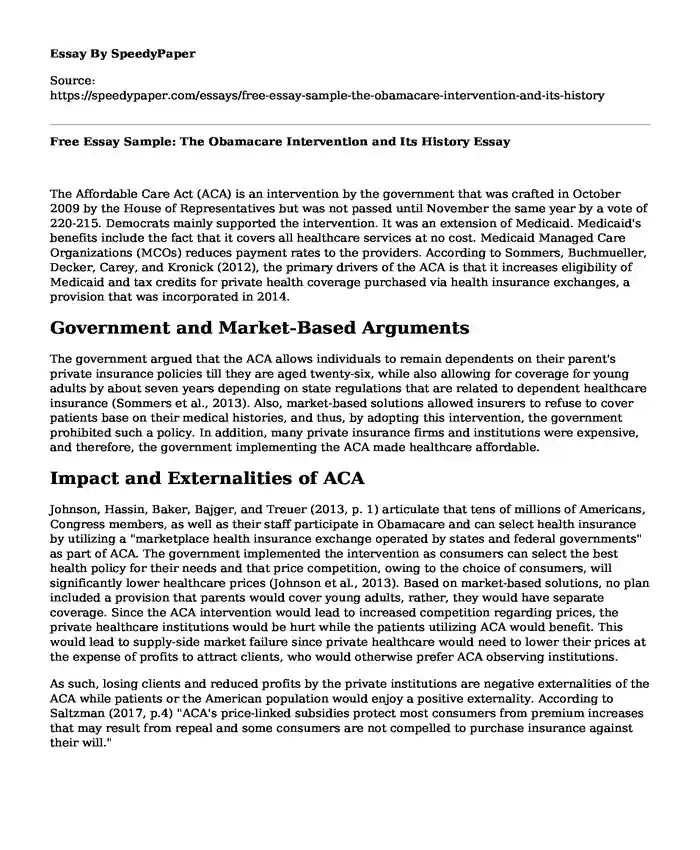
| Type of paper: | Essay |
| Categories: | Healthcare policy Barack Obama |
| Pages: | 3 |
| Wordcount: | 710 words |
The Affordable Care Act (ACA) is an intervention by the government that was crafted in October 2009 by the House of Representatives but was not passed until November the same year by a vote of 220-215. Democrats mainly supported the intervention. It was an extension of Medicaid. Medicaid's benefits include the fact that it covers all healthcare services at no cost. Medicaid Managed Care Organizations (MCOs) reduces payment rates to the providers. According to Sommers, Buchmueller, Decker, Carey, and Kronick (2012), the primary drivers of the ACA is that it increases eligibility of Medicaid and tax credits for private health coverage purchased via health insurance exchanges, a provision that was incorporated in 2014.
Government and Market-Based Arguments
The government argued that the ACA allows individuals to remain dependents on their parent's private insurance policies till they are aged twenty-six, while also allowing for coverage for young adults by about seven years depending on state regulations that are related to dependent healthcare insurance (Sommers et al., 2013). Also, market-based solutions allowed insurers to refuse to cover patients base on their medical histories, and thus, by adopting this intervention, the government prohibited such a policy. In addition, many private insurance firms and institutions were expensive, and therefore, the government implementing the ACA made healthcare affordable.
Impact and Externalities of ACA
Johnson, Hassin, Baker, Bajger, and Treuer (2013, p. 1) articulate that tens of millions of Americans, Congress members, as well as their staff participate in Obamacare and can select health insurance by utilizing a "marketplace health insurance exchange operated by states and federal governments" as part of ACA. The government implemented the intervention as consumers can select the best health policy for their needs and that price competition, owing to the choice of consumers, will significantly lower healthcare prices (Johnson et al., 2013). Based on market-based solutions, no plan included a provision that parents would cover young adults, rather, they would have separate coverage. Since the ACA intervention would lead to increased competition regarding prices, the private healthcare institutions would be hurt while the patients utilizing ACA would benefit. This would lead to supply-side market failure since private healthcare would need to lower their prices at the expense of profits to attract clients, who would otherwise prefer ACA observing institutions.
As such, losing clients and reduced profits by the private institutions are negative externalities of the ACA while patients or the American population would enjoy a positive externality. According to Saltzman (2017, p.4) "ACA's price-linked subsidies protect most consumers from premium increases that may result from repeal and some consumers are not compelled to purchase insurance against their will."
Cost Trend
Data from ALFRED shows the government cost trend on Medicaid, which is inclusive of the ACA intervention has increased cumulatively since 2009 to 2017, which implies that the government under Obama and Trump has increasingly invested in the ACA and Medicaid as shown in Figure 1 below.
Figure 1: Government expenditure and cost trend on Medicaid. Source: ALFRED (n.d).
The success of ACA and Recommendation
The fall of healthcare expenditure reveals that the intervention has been a success. According to Bengoa and Arratibel (2018), Obamacare has generated savings of $417 million for Medicare and subsequently prevented about 150,000 hospital readmissions, as well as ensured price reduction for healthcare. Even though the government has increased its expenditure on ACA since 2009, savings for healthcare have been achieved. This implies that ACA has been a success as it has achieved its objectives of lowering the cost of healthcare in the US. For this reason, it is recommendable that ACA should be continued.
References
ALFRED (n.d). Personal current transfer receipts: Government social benefits to persons: Medicaid (W729RC1A027NBEA). Retrieved from https://alfred.stlouisfed.org/series?seid=W729RC1A027NBEA
Bengoa, R., & Arratibel, P. (2018). After prioritizing, implementation. Prioritising Health Services or Muddling Through, 145-149.
Johnson, E. J., Hassin, R., Baker, T., Bajger, A. T., & Treuer, G. (2013). Can consumers make affordable care affordable? The value of choice architecture. PloS one, 8(12), 1-6.
Saltzman, E. (2017). Demand for health insurance: Evidence from the California and Washington ACA marketplaces. Wharton School, 1-66.
Sommers, B. D., Buchmueller, T., Decker, S. L., Carey, C., & Kronick, R. (2013). The Affordable Care Act has led to significant gains in health insurance and access to care for young adults. Health Affairs, 32(1), 165-174.
Cite this page
Free Essay Sample: The Obamacare Intervention and Its History. (2022, Jun 14). Retrieved from https://speedypaper.net/essays/free-essay-sample-the-obamacare-intervention-and-its-history
Request Removal
If you are the original author of this essay and no longer wish to have it published on the SpeedyPaper website, please click below to request its removal:
- Role of Social Media Essay Sample
- Free Essay Example on Customer Service in a Hotel
- Marketing Essay Sample: Role of Personal Selling in an Organization
- Essay Example: Opposing Op-Ed on Assisted Suicide within Canada
- Motivation for Academic Writing, Free Paper for Students
- A Look into Osugi Sakae's Life, Biographical Essay Sample
- Essay Sample on How Race Determines Confidence in Educational Institutions in the US
Popular categories




